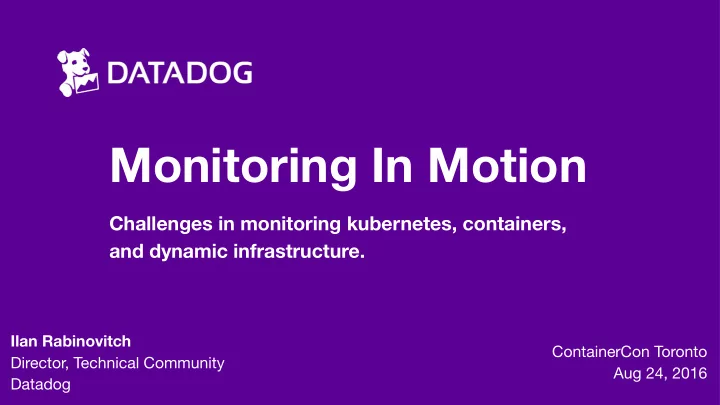

Monitoring In Motion Challenges in monitoring kubernetes, containers, and dynamic infrastructure. Ilan Rabinovitch ContainerCon Toronto Director, Technical Community Aug 24, 2016 Datadog
$ finger ilan@datadog [datadoghq.com] Name: Ilan Rabinovitch Role: Director, Technical Community Interests: * Monitoring and Metrics * Large scale web operations * FL/OSS Community Events
Datadog Overview • SaaS based infrastructure and app monitoring • Open Source Agent • Time series data (metrics and events) • Processing nearly a trillion data points per day • Intelligent Alerting • We’re hiring! (www.datadoghq.com/careers/)
Monitor Everything Operating Systems, Cloud Providers, Containers, Web Servers, Datastores, Caches, Queues and more...
$ cat ~/.plan 1. Intro: The Importance of Monitoring 2. The Challenge : Monitoring Dynamic Infrastructure 3. Finding the Signal: How do we know what to monitor? 4. Implementation: Applying it to Containerized Workloads
Our Focus Area Culture Automation Metrics Sharing Damon Edwards and John Willis DevOps Day LA
Culture “ organizations which design systems ... are constrained to produce designs which are copies of the communication structures of these organizations ” - Melvin E. Conway
Follow @honest_update on Twitter
Collecting data is cheap; not having it when you need it can be expensive
Instrument all the things!
Sharing Looping Back on Culture Describe the problem as your “enemy” not each other Learn Together
Sharing Using and Sharing the same metrics and measurements across teams is key to avoiding misunderstandings.
Source: http://bit.ly/1SvvbuP
Source: http://bit.ly/1RQRsXW
Operational Complexity Increases with.. • Number of things to measure • Velocity of change
https://www.datadoghq.com/docker-adoption/
How much we measure? 1 instance • 10 metrics from cloud providers 1 operating system (e.g., Linux) • 100 metrics 50~ metrics per application
How much we measure? 1 instance • 10 metrics from cloud providers 1 operating system (e.g., Linux) • 100 metrics 50~ metrics per application N containers • 150*N metrics
Operational Complexity 500 100 containers instances
Operational Complexity: Scale 800 160 metrics per host metrics per host Assuming 5 containers per host
Operational Complexity: Scale 80,000 100 instances metrics Assuming 5 containers per host
How much we measure? Metrics Overload! 1 instance • 10 metrics from cloud providers 1 operating system (e.g., Linux) • 100 metrics 50~ metrics per application N containers • 150*N metrics
Operational Complexity Increases with.. • Number of things to measure • Velocity of change
Source: Datadog
Source: http://bit.ly/1qFylWK
Operational Complexity Increases with.. • Number of things to measure • Velocity of change
Open Questions • Where is my container running? • What is the capacity of my cluster? • What port is my app running on? • What’s the total throughput of my app? • What’s its response time per tag? (app, version, region) • What’s the distribution of 5xx error per container?
Source: http://bit.ly/1YxJ7Jy
More Details at: http://www.datadoghq.com/blog/monitoring-101-alerting/
Monitoring 101
Finding Signal - Categorizing Your Metrics
Examples: NGINX - Metrics Work Metrics: Resource Metrics: • Requests Per Second • Disk I/O • Request Time • Memory • Error Rates (4xx or 5xx) • CPU • Success (2xx) • Queue Length
Examples: NGINX - Events • Configuration Change • Code Deployment • Service Started / Stopped
Examples: Events
When to let a sleeping engineer lie?
When to alert?
Recurse until you find root cause
What to demand from our monitoring tooling?
Cryptic Alerts ? T A H W
EVERY ALERT MUST BE ACTIONABLE
Host Centric
Service Centric
Static vs Dynamic Static configurations tracking dynamic infrastructure are not a recipe for success.
Query Based Monitoring “What’s the average throughput of application:nginx per version ?” “Alert me when one of my pod from replication controller:foo is not behaving like the others?” “Show me rate of HTTP 500 responses from nginx” “… across all data centers” “… running my app version 2….”
Getting at the metrics…
Resource Metrics Utilization: Saturation • CPU (user + system) • throttling • memory • swap • i/o • network traffic Error • Network Errors (receive vs transmit)
Container Events • Starting / Stopping Containers • Scaling Events for Underlying Instances • Deploying a new container build
How do we get at the upper layers?
Getting at the Metrics NETWORK CPU METRICS MEMORY METRICS I/O METRICS METRICS pseudo-files Yes Yes Some Yes, in 1.6.1+ stats command Basic Basic No Basic API Yes Yes Some Yes
Pseudo-files • Provide visibility into container metrics via the file system. • Generally under: /cgroup/<resource>/docker/$CONTAINER_ID/ or /sys/fs/cgroup/<resource>/docker/$CONTAINER_ID/
Pseudo-files: CPU Metrics $ cat /sys/fs/cgroup/cpuacct/docker/$CONTAINER_ID/cpuacct.stat > user 2451 # time spent running processes since boot > system 966 # time spent executing system calls since boot Pseudo-files: CPU Throttling $ cat /sys/fs/cgroup/cpu/docker/$CONTAINER_ID/cpu.stat > nr_periods 565 # Number of enforcement intervals that have elapsed > nr_throttled 559 # Number of times the group has been throttled > throttled_time 12119585961 # Total time that members of the group were throttled (12.12 seconds)
Docker API • Detailed streaming metrics as JSON HTTP socket $ curl -v --unix-socket /var/run/docker.sock http://localhost/containers/ 28d7a95f468e/stats
STATS Command # Usage: docker stats CONTAINER [CONTAINER...] $ docker stats $CONTAINER_ID CONTAINER CPU % MEM USAGE/LIMIT MEM % NET I/O BLOCK I/O ecb37227ac84 0.12% 71.53 MiB/490 MiB 14.60% 900.2 MB/275.5 MB 266.8 MB/872.7 MB
Side Car Containers
Aren’t we still missing a layer?
Open Questions • What is the capacity of my cluster? • What’s the total throughput of my app? • What’s its response time per tag? (app, version, region) • What’s the distribution of 5xx error per container? • Where is my container running? what port?
Service Discovery A O A O Integration Configurations Host Level Monitoring Agent Config Backend Metrics Container Additional Metadata Containers List & (Tags, etc) Metadata Docker API Orchestrator
Custom Metrics • Instrument custom applications • You know your key transactions best. • Use async protocols like Etys’ STATSD or DogstatsD
Source: http://bit.ly/1NoW6aj
Resources Monitoring 101: Alerting https://www.datadoghq.com/blog/monitoring-101-alerting/ Monitoring 101: Collecting the Right Data https://www.datadoghq.com/blog/monitoring-101-collecting-data/ Monitoring 101: Investigating performance issues https://www.datadoghq.com/blog/monitoring-101-investigation/ The Power of Tagged Metrics https://www.datadoghq.com/blog/the-docker-monitoring-problem/ How to Collect Docker Metrics https://www.datadoghq.com/blog/how-to-collect-docker-metrics/ 8 surprising facts about Docker Adoption https://www.datadoghq.com/docker-adoption/
Recommend
More recommend